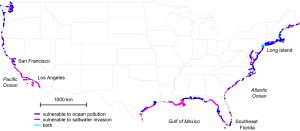By George Bao Aug. 4, 2016

PASADENA, CALIFORNIA — Coastal waters and near-shore groundwater supplies along more than a fifth of coastlines in the continental United States are vulnerable to contamination from previously hidden underground transfers of water between the oceans and land.
The finding was published online in the journal Science Thursday by a new study by researchers at the Ohio State University, Columbus, and NASA’s Jet Propulsion Laboratory, Pasadena, California.
The study offers the first-ever map of the underground flows that connect fresh groundwater beneath the continental United States and seawater in the surrounding oceans.
The map highlights areas most vulnerable to degraded water quality from these flows now and in the future.

The researchers combined U.S. topographic data and NASA climate models to identify key inland regions that contribute groundwater and contaminants to the coast.
They examined rainfall, evaporation rates and the amount of known surface runoff to calculate the missing portion of water that was running out below ground, then melded those results with terrain and land-use data to identify where the water ended up.
The team was able to learn more about the previously hidden water exchanges via computer analyses, without extensive and costly field surveys.
Audrey Sawyer, assistant professor of Earth Sciences at the Ohio State University and leader of the study, said that while scientists have long known that freshwater and seawater mix unseen below ground, until now they hadn’t been able to pinpoint exactly where it was happening, or how much, except in limited locations.
The study identified 12 percent of the continental U.S. coastline — including the northern Gulf Coast from Mississippi to the Florida Panhandle, northern Atlantic Coast and Pacific Northwest — as areas where once-hidden drainage systems make the ocean most susceptible to contamination from septic tanks and fertilizer in freshwater.
There, excess nutrients in the water can cause harmful algal blooms to form, which remove vital oxygen from the water. This contamination from land to sea endangers fisheries and coral reefs, as well as water recreation and tourism.
In contrast, the team found that another 9 percent of coastline — including confirmed locations such as Southeastern Florida, Southern California and Long Island, New York — are especially susceptible to the opposite threat: contamination from sea to land. In these areas, saltwater intrudes inland and infiltrates the fresh groundwater supply.
Overall, the study calculates that more than 15 billion tons of freshwater flow through invisible underground networks into the ocean along the continental U.S. coastline every year. That sounds like a lot of water, but it’s less than 1 percent of the total amount that flows from the continental United States into the ocean, said study co-author Cedric David of JPL. The other 99 percent comes from rivers and surface runoff.
Still, David explained, the study is significant because it provides the first continental-scale, high-resolution estimate of that 1 percent — a portion which, when compared to the other 99 percent, can be particularly rich in nutrients and other contaminants.
Researchers created the first-ever map of previously hidden underground flows of water connecting fresh groundwater supplies beneath the continental United States with seawater in the oceans.
According to the study, 21 percent of the U.S. coastline was found to be susceptible to land-to-sea or sea-to-land water contamination.
The analysis may help water managers better plan strategies for coastal land development and groundwater management to preserve water quality.
